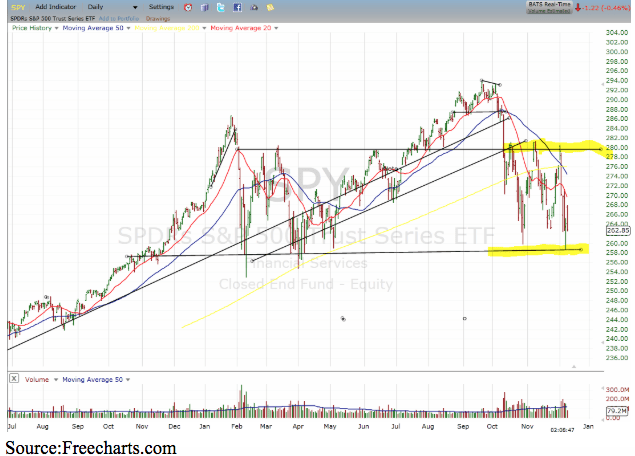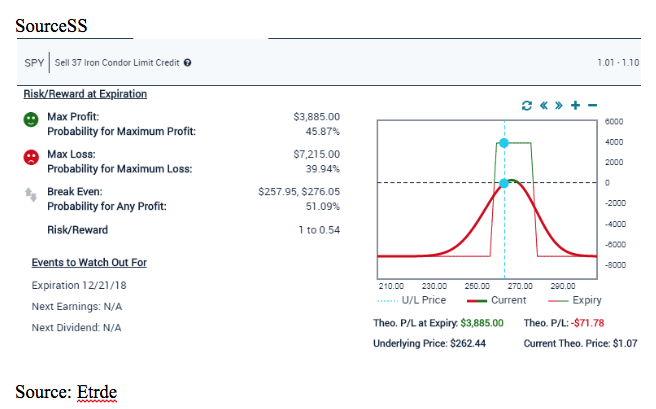The stock market continues to fluctuate wildly, on Monday the Dow Jones went from being down 500 points to close positive. Today, it quickly erased a 350-point gain. But within these huge intraday swings, the market seems to be carving out a defined range. This creates a good opportunity for selling credit spreads in general and iron condors specifically.
The trade I will focus on is in the SPY — with expectations that it will remain between $260 and $280 for the next two weeks.

But before I get to the specific trade, let’s discuss credit spreads and iron condors.
Many traders of iron condors and credit spreads tend to enter their trades every first or second week of the month, or they have established a hard number of days before expiration where they forced themselves to enter their positions mechanically.
In my experience, this is not the best way to trade these strategies. This doesn’t mean you cannot be profitable trading that way, merely that I personally think there are better ways.
The problem with Iron Condors and Credit spreads is that you are usually risking a lot to win a little. So, entering a position is not something you should take lightly. It is my personal belief that they should only be traded when the odds are clearly in your favor. If the conditions are not given, then staying put is the best decision.
These are the ideal conditions under which I would enter a trade:
For Bear Call Spreads:
- 70% or more of stocks above their 20 Simple Day Moving Average.
- Stochastics Oscillator (80, 20, 8, 3) above 80.
- McClellan Oscillator above +150
For Bull Put Spreads:
- 30% or less of stocks below their 20 Simple Day Moving Average.
- Stochastics Oscillator (80, 20, 8, 3) below 20.
- McClellan Oscillator below -150.
- The logic behind these entry conditions is that for those elements to be present the market usually has to make a pretty sizeable move, and by then, chances are increasingly higher that it will need to digest the move — that is trade sideways or pull back.
Let’s say 70% of stocks are above their 20 SMA, and both Stochastics and McClellan are overbought. At that point, the market has probably made at least a 5% run upwards. If at that point you can sell a Call Credit Spread 5% above the current price, then you are challenging the market to make a total run of 10% upwards. In a one-month period, or a little bit more than that. Needless to say, a market moving 10% in one direction over one month is a highly unlikely event. It will happen from time to time, but your winners should outnumber your eventual losses if you play them all.
Many traders get creamed trying to pick an exact bottom or exact top. That’s impossible. So, my advice is that even though the markets are overbought or oversold by the parameters described above, never sell your credit spreads less for than 3% away from current market price. Try to always sell at strike prices that are at least 4% or more away from current prices. That gives you room for error. You may not guess the exact top or bottom, but the market still needs to make another big move to cause you a loss.
Going back to the previous example, In the event that the market threatens your Bear Call position, you can adjust it further up. That is, close it (for a temporary loss) and open another Bear Call spread 3 % to 4% even further up, and now you are challenging the market to a total move of 13% – 14% in a month, a very unlikely event.
The Opportunity Factor
If you were to wait for all three conditions to be present, then you would only end up trading three or four positions in the year. Those would be very good trades and potentially profitable and easy to ride. But very few for many traders. In order to mitigate this effect and give myself some more trading opportunities, I tend to relax the rule in certain periods.
For example, during historically bearish periods, I would only need two of the three rules to be true in order to sell Call credit spreads. But I would expect to see the three conditions fulfilled for selling Put Credit spreads. Likewise, during December and January, I would expect all three conditions to be met in order to sell Calls, but I could relax the rules expecting only two of them to be met in order to sell Puts because it is a naturally bullish season of the year.
Allocation
It is my personal preference to risk no more than 15% of my capital in one position. Now, that doesn’t mean I am willing to lose 15% of my portfolio that would be bonkers. That means that is the amount of money I put to work.
So, assuming I’m working with a $50,000 account I’d allocate approximately $7,000 to the trade.
Specifically, I’m looking at is in the SPY to sell iron condor using the 256/259 put spread and the 275/278 call spread with the December 21st expiration.
I can collect a total credit of $1.05, meaning my risk is $1.95 per meaning I can do 37 contracts.
Here is what the risk/reward profile of the trade looks like.

Human beings are social being in nature, and the herd mentality comes impregnated in our brains at the time we are born. It feels just comfortable to trade in agreement with the crowd, but that’s the best way to lose this game.
Paraphrasing Warren Buffet, you will enter a bullish trade (Bull Put spread) when everybody is scared, and you will enter a bearish trade (Bear Call Spread) when everyone is greedy.
When establishing credit spreads and iron condors give yourself some room for error, selling at least 4% away from current price and that room is there to give you the confidence boost that you need in order to bet against the crowd.
About the Author: Steve Smith

Steve has more than 30 years of investment experience with an expertise in options trading. He’s written for TheStreet.com, Minyanville and currently for Option Sensei. Learn more about Steve’s background, along with links to his most recent articles. More...
9 "Must Own" Growth Stocks For 2019
Get Free Updates
Join thousands of investors who get the latest news, insights and top rated picks from StockNews.com!






